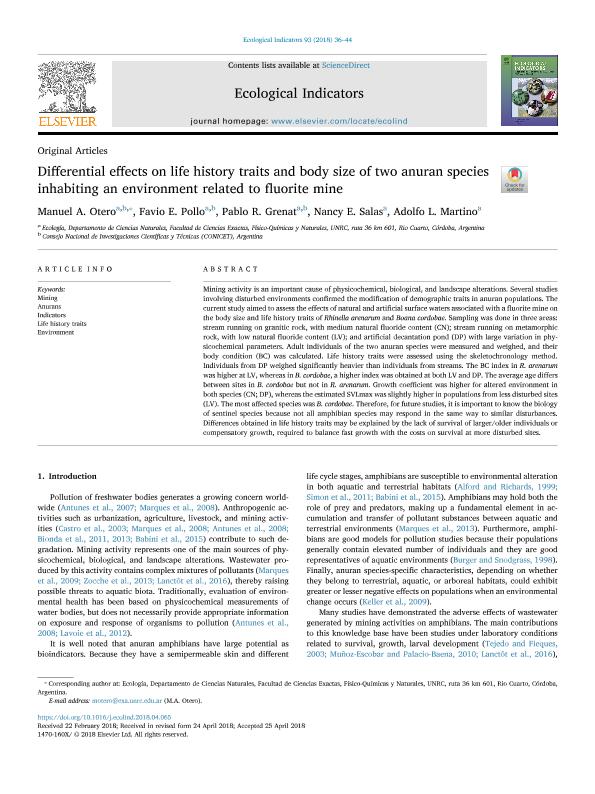Mostrar el registro sencillo del ítem
dc.contributor.author
Otero, Manuel Alejandro

dc.contributor.author
Pollo, Favio Ezequiel

dc.contributor.author
Grenat, Pablo Raúl

dc.contributor.author
Salas, Nancy Edith

dc.contributor.author
Martino, Adolfo Ludovico

dc.date.available
2021-08-22T21:57:49Z
dc.date.issued
2018-10
dc.identifier.citation
Otero, Manuel Alejandro; Pollo, Favio Ezequiel; Grenat, Pablo Raúl; Salas, Nancy Edith; Martino, Adolfo Ludovico; Differential effects on life history traits and body size of two anuran species inhabiting an environment related to fluorite mine; Elsevier Science; Ecological Indicators; 93; 10-2018; 36-44
dc.identifier.issn
1470-160X
dc.identifier.uri
http://hdl.handle.net/11336/138675
dc.description.abstract
Mining activity is an important cause of physicochemical, biological, and landscape alterations. Several studies involving disturbed environments confirmed the modification of demographic traits in anuran populations. The current study aimed to assess the effects of natural and artificial surface waters associated with a fluorite mine on the body size and life history traits of Rhinella arenarum and Boana cordobae. Sampling was done in three areas: stream running on granitic rock, with medium natural fluoride content (CN); stream running on metamorphic rock, with low natural fluoride content (LV); and artificial decantation pond (DP) with large variation in physicochemical parameters. Adult individuals of the two anuran species were measured and weighed, and their body condition (BC) was calculated. Life history traits were assessed using the skeletochronology method. Individuals from DP weighed significantly heavier than individuals from streams. The BC index in R. arenarum was higher at LV, whereas in B. cordobae, a higher index was obtained at both LV and DP. The average age differs between sites in B. cordobae but not in R. arenarum. Growth coefficient was higher for altered environment in both species (CN; DP), whereas the estimated SVLmax was slightly higher in populations from less disturbed sites (LV). The most affected species was B. cordobae. Therefore, for future studies, it is important to know the biology of sentinel species because not all amphibian species may respond in the same way to similar disturbances. Differences obtained in life history traits may be explained by the lack of survival of larger/older individuals or compensatory growth, required to balance fast growth with the costs on survival at more disturbed sites.
dc.format
application/pdf
dc.language.iso
eng
dc.publisher
Elsevier Science

dc.rights
info:eu-repo/semantics/openAccess
dc.rights.uri
https://creativecommons.org/licenses/by-nc-nd/2.5/ar/
dc.subject
ANURANS
dc.subject
ENVIRONMENT
dc.subject
INDICATORS
dc.subject
LIFE HISTORY TRAITS
dc.subject
MINING
dc.subject.classification
Conservación de la Biodiversidad

dc.subject.classification
Ciencias Biológicas

dc.subject.classification
CIENCIAS NATURALES Y EXACTAS

dc.title
Differential effects on life history traits and body size of two anuran species inhabiting an environment related to fluorite mine
dc.type
info:eu-repo/semantics/article
dc.type
info:ar-repo/semantics/artículo
dc.type
info:eu-repo/semantics/publishedVersion
dc.date.updated
2021-08-13T16:22:50Z
dc.journal.volume
93
dc.journal.pagination
36-44
dc.journal.pais
Países Bajos

dc.journal.ciudad
Amsterdam
dc.description.fil
Fil: Otero, Manuel Alejandro. Universidad Nacional de Río Cuarto. Facultad de Ciencias Exactas Fisicoquímicas y Naturales. Departamento de Ciencias Naturales. Cátedra de Ecología; Argentina. Consejo Nacional de Investigaciones Científicas y Técnicas; Argentina
dc.description.fil
Fil: Pollo, Favio Ezequiel. Consejo Nacional de Investigaciones Científicas y Técnicas; Argentina. Universidad Nacional de Río Cuarto. Facultad de Ciencias Exactas Fisicoquímicas y Naturales. Departamento de Ciencias Naturales. Cátedra de Ecología; Argentina
dc.description.fil
Fil: Grenat, Pablo Raúl. Universidad Nacional de Río Cuarto. Facultad de Ciencias Exactas Fisicoquímicas y Naturales. Instituto de Ciencias de la Tierra, Biodiversidad y Ambiente - Consejo Nacional de Investigaciones Científicas y Técnicas. Centro Científico Tecnológico Conicet - Córdoba. Instituto de Ciencias de la Tierra, Biodiversidad y Ambiente; Argentina
dc.description.fil
Fil: Salas, Nancy Edith. Universidad Nacional de Río Cuarto. Facultad de Ciencias Exactas Fisicoquímicas y Naturales. Departamento de Ciencias Naturales. Cátedra de Ecología; Argentina
dc.description.fil
Fil: Martino, Adolfo Ludovico. Universidad Nacional de Río Cuarto. Facultad de Ciencias Exactas Fisicoquímicas y Naturales. Departamento de Ciencias Naturales. Cátedra de Ecología; Argentina
dc.journal.title
Ecological Indicators

dc.relation.alternativeid
info:eu-repo/semantics/altIdentifier/url/http://linkinghub.elsevier.com/retrieve/pii/S1470160X18303182
dc.relation.alternativeid
info:eu-repo/semantics/altIdentifier/doi/http://dx.doi.org/10.1016/j.ecolind.2018.04.065
Archivos asociados
